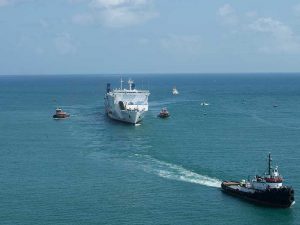
Ardent had Caribbean Fantasy covered
AUGUST 29, 2016 — The 561 ft cruise ferry Caribbean Fantasy which caught fire off Puerto Rico on August 17 is covered by an OPA-90, Salvage and Marine Fire Fighting “SMFF” coverage

AUGUST 29, 2016 — The 561 ft cruise ferry Caribbean Fantasy which caught fire off Puerto Rico on August 17 is covered by an OPA-90, Salvage and Marine Fire Fighting “SMFF” coverage
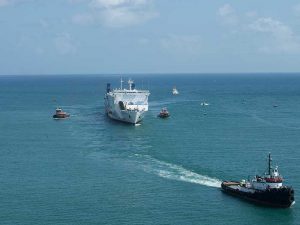
AUGUST 29, 2016 — The 561 ft cruise ferry Caribbean Fantasy which caught fire off Puerto Rico on August 17 is covered by an OPA-90, Salvage and Marine Fire Fighting “SMFF” coverage

AUGUST 15, 2016 — Crowley Maritime Corporation has promoted veteran company executive Eric Evans to vice president of strategy, a newly-created position that will focus on facilitating long-term growth through external business
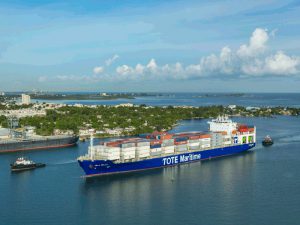
Leading shipowners and operators, gas suppliers, ports, class societies, and technologists gathered last month in London to announce a new cross-industry initiative aimed at accelerating the adoption of Liquefied Natural Gas (LNG) as a marine fuel. The initiative hopes to address the issues of LNG bunkering infrastructure, regulatory concerns, and the higher initial capital investment costs in building LNG-fueled vessels.
Called SEA/LNG, the initiative brings together participants from Carnival Corporation & plc, DNV GL, ENGIE, ENN, GE, GTT, Lloyd’s Register, Mitsubishi Corporation, NYK Line, Port of Rotterdam, Qatargas, Shell, TOTE Inc. and Wärtsilä.
The goal of the initiative explains TOTE Inc. Executive Vice President Peter Keller, who is serving as SEA\LNG’s Chairman, is to address “market barriers and help transform the use of LNG as a marine fuel into a global reality.”
When it comes to using LNG as a marine fuel, TOTE is all in. It’s committed about $500 million in capital investments to have its entire fleet to burn LNG. The U.S.-flag operator has built two 3,100 TEU LNG-fuelled containerships now in operation between the Port of Jacksonville, FL, and San Juan, PR, and is converting the two ORCA Class Roll-on/Roll-Off ships in its fleet to burn LNG. The first of those two is being converted at Singapore’s Keppel Shipyard this fall.
TOTE is not alone in adding dual-fuel and LNG-Ready tonnage to its oceangoing fleet in the U.S. Harvey Gulf International Marine, Crowley Maritime Corp., Matson Navigation, Kinder Morgan, and SEA VISTA/SEACOR all have vessels in operation or under construction that burn or could eventually burn LNG as a marine fuel. In all, there are 29 vessels that are designed or could be converted to burn LNG as shown in the accompanying table. This does not include inland and coastal vessels such as towboats or ferries.
The U.S. Maritime Administration, for example, is supporting the conversion of a towboat to burn LNG as fuel.
The use of LNG as a marine fuel has increased with Emission Control Areas (ECAs) coming into force in Northern Europe and North America under MARPOL Annex VI. LNG is relatively clean burning, containing virtually no sulfur content and it produces lower NOx and particulate matter in the combustion process than fuel oil and marine diesel oil.
A long-time, well-known proponent of LNG as a marine fuel, John Hatley, PE, Gas Initiatives Wärtsilä North America, sees gas as a compelling solution for box feeders, RO/RO vessels, ferries and cruise ships, product tankers, Great Lakes vessels, and ATBs on short coastal voyages that enter into ECAs.
LNG is therefore able to offer a fuel solution compliant with both current and anticipated future regulations.
The larger effect from Annex VI will come when the requirement to reduce sulfur content of marine fuels to 0.5% on a global basis effective 2020 or 2025 depending on the outcome of an IMO low sulfur fuel availability study to be completed in 2018. The issue for ship owners and operators is how to find alternatives to economically meet the low sulfur fuel mandate about to be imposed by MARPOL Annex VI.
However, while LNG is a competitive fuel relative to current alternatives, LNG infrastructure is needed in ports around the world to enable quick, safe and cost effective bunkering. In the U.S., the first LNG bunker transport barge with GTT Mark III Flex tank technology is under construction at Conrad Orange shipyard in Orange, TX, and expected to be delivered in early 2017. LNG bunkering infrastructure is far more advanced in Europe.
“Everybody is calling for alternatives to reduce environmental impacts says Philip Olivier, CEO of ENGIE Global LNG. “That’s why we have joined forces to actively promote LNG as a key fuel in maritime transport. LNG has the potential to take a 10% market share of global bunker demand by 2030. ENGIE will contribute to achieving this target.”
Tom Strang, Senior Vice President, Maritime Affairs, Carnival Corporation & plc, says, “By working together proactively across the whole marine LNG value chain we can make the transition to a lower emission marine sector a reality.”
Lauran Wetemans Shell’s general manager downstream LNG agrees. “To make the transition to LNG as a fuel happen it needs close collaboration with key players across the full value chain,” says, Wetemans. “SEA/LNG aims to promote the benefits and potential of LNG fuel, and create a level playing field for LNG with other fuels. It will complement the work being done by other organizations like the Society for Gas as a Marine Fuel.”
Leo Karistios, Gas Technology Lead, Lloyd’s Register, points out, “LNG fuelled shipping has mainly been for the visionaries and, until now, concentrated in specialist ship sectors: short sea shipping and ferries, mainly sailing between two fixed ports. We want to help drive the expansion of LNG as a marine fuel of choice, with not just more short sea and local ships burning gas, but also the deep sea trades.”
Timo Koponen, Vice President, Flow & Gas Solutions, Wärtsilä Marine Solutions, says his company will contribute “its vast experience and know-how in gas driven propulsion systems and the entire gas value chain” to the initiative. “By working together, we plan to overcome the challenges and speed the general acceptance of LNG. Having been a pioneer in the use of LNG as a marine fuel, and a developer of major technologies facilitating the adoption of LNG fuel, it is natural that Wärtsilä supports wholeheartedly the aims of the SEA/LNG coalition.”
Developing bulk carrier concept
Wärtsilä is also involved with an effort with class society ABS, Arista Shipping, Deltamarin, and GTT in the Project Forward joint development project (JDP) to develop a dry bulk carrier concept that employs LNG as fuel.
The goal is to develop a Kamsarmax bulk carrier design to be the first of this type suitable for worldwide services powered by LNG in compliance with the IMO’s Energy Efficiency Design Index 2025 standards, NOx Tier III and MARPOL Annex VI SOx emission levels. This landmark design will be the first LNG-fueled cargo ship capable of full-range operations.
“The long-term potential for LNG as a marine fuel is tremendous,” says ABS Vice President of Global Gas Solutions Patrick Janssens. “We see the near-term opportunities for larger vessels on fixed and known trade routes, but more opportunities will emerge as concepts mature and bunkering infrastructure expands. Environmental stewardship will continue to be a concern, and owners will be evaluating alternative fuel choices.”
“Project Forward represents a milestone for the shipping industry in bringing to the market a practical, achievable design for what are the workhorses of the shipping fleet,” says Arista Shipping Principal Alexander P. Panagopulos. “Our mission is to develop the next generation of energy efficient and environmentally friendly dry bulk cargo ships to be sustainable worldwide beyond 2030. It marks a number of ‘firsts’ and draws together the experience of a team of leaders in their field to make LNG powered shipping a reality on the high seas.”
Technical challenges in developing this design were considerable, as there is a need to carry a large volume of LNG (2,500 m3) – which corresponds to full-range operation and 40 days – in a type of ship where available space is limited and cargo space is at a premium.
ABS will provide Approval in Principle (AIP) for the concept, which is based on the highly optimized Deltamarin B.Delta 82 design, utilizing a GTT membrane LNG fuel tank. This design also could be applied to other bulk carrier sizes and serve as the basis for an LNG-fueled tanker. The concept features a Wärtsilä four-stroke, medium-speed engine without auxiliary generators, the first time this configuration has been applied to a vessel of this type, significantly simplifying the vessel’s engine room arrangement and contributing to lower capital expenditure.
Read more from our Green Technology & Sustainable Shipping section in our Digital Edition.
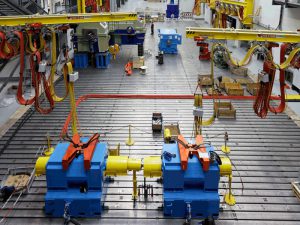
Vessel operators are still very much focused on reducing fuel consumption and lowering emissions. Collaboration early on in the design of a new vessel and its construction between the vessel owner, naval architects, shipbuilders, and propulsion manufacturers can payoff in optimizing the vessel’s hull, reducing costs of construction, and lowering operational costs during a vessel’s lifetime.
“We work with naval architects early in the design process to help optimize the propulsion system, looking to meet all design requirements while minimizing the size and horsepower of the system,” says Elizabeth Boyd, PE, President, Nautican Research & Development Ltd. Boyd says collaboration early in the design phase “can result in significant savings because if the horsepower can be reduced due to efficiency gains, it can lead to size reductions in not just the horsepower and propellers, but also everything that goes along with it—shafts, bearings, etc.—sometimes it can even mean meeting the requirements with a smaller boat. We can quickly show performance and full system configuration for different sizes, allowing the naval architect to explore options very quickly.”
Nautican’s foundation was built on efficiency. More than 40 years ago, company founder Josip Gruzling pioneered the use of hydrofoils to increase the efficiency of tugs and barges. Today, Nautican engineers and manufactures hydrodynamic solutions, including patented Integrated Propulsion Units, High efficiency nozzles and propellers, high aspect ratio triple rudders, pre-swirl stators, and also hydralift skegs for barges. It says independent tests show that its propulsion system solutions increase power and maneuverability, while significantly reducing fuel use and maintenance needs.
One of the Nautican’s latest projects is fabricating the first two sets of 104-inch nozzle units for the 120 ft Kirby Offshore Marine line haul tugs under construction at Nichols Brothers Boat Builders, Whidbey Island, WA.
According to Boyd, initially nozzle development was done using both Computational Fluid Dynamics (CFD) and physical testing in a cavitation tunnel and towing tank. “However,” she says, “our CFD efforts now are focused more on integration with the hull form. For these boats, CFD was not used as the design was already well developed and fairly straight-forward as far as placing the nozzles.”
The designer of the ABS Class tugs is Jensen Maritime, Crowley Maritime Corp.’s Seattle-based naval architecture and marine engineering company.
Each of the two tugboats will be equipped with two Caterpillar 3516C main engines, rated at 2,447 hp at 1,600 rev/min. Reintjes reduction gears, supplied by Karl Senner, LLC, Kenner, LA, will turn two Nautican fixed-pitch propellers with fixed nozzles. Other equipment onboard the tugs will include two C7.1 Caterpillar generators for electrical service, one TESD-34 Markey tow winch, one CEW-60 Markey electric capstan and one Smith Berger Town Pin.
“Kirby owns many boats with Nautican systems, but most of these have been ATBs (Articulated Tug Barge units) to date,” says Boyd. “We worked recently with Nichols on a pair of Kirby 10,000 hp ATB tugs—this project went very well and these vessels are performing exceptionally well in service.”
Nautican designed larger 120 inch nozzle units for another tug for Dunlap Towing. “Dunlap is a Nautican repeat customer,” says Boyd. The new tug, says Boyd is a new design, based on the Phyllis Dunlap, but “fully rethought and redesigned by Hockema Whalen.”
The 5,000 hp, twin-screw tug Phyllis Dunlap was built in 2001 by Hansen Boat Company, Everett, WA.
“Dunlap has been a great customer to work with—they are very involved in all aspects of the design and equipment selection and are very knowledgeable, providing some really useful feedback about performance over the years in their very demanding runs to Hawaii and Alaska.”
Wärtsilä Transverse Thruster
Earlier this year, Wärtsilä expanded its transverse thruster series with the addition of the Wärtsilä WTT-40, with a 4,000 kW power level and a 3,400 mm diameter controllable pitch propeller. While Wärtsilä has designed and built customized transverse thrusters as powerful as 5,500 kW, the WTT-40 and others in the WTT range address customer needs for high power transverse thrusters for bow and stern applications.
Development work on the Wärtsilä WTT-40 began in 2015 with an eye on targeting cruise ships, large OSVs and offshore construction vessels. The high power level is particularly important for the harbor maneuvering and docking of large ships, and for dynamic positioning of offshore vessels working in heavy sea conditions.
Because of its maximum power of 4,000 kW, shipyards and cruise vessel designers have the option of using three WTT-40 thrusters instead of four smaller ones. This translates into a more efficient vessel design with less space required for the transverse thrusters. It also allows thrusters to be installed closer to the bow where they are more effective.
Wärtsilä’s extensive experience with propeller design and tunnel optimizations using CFD analysis, ensures an optimal solution when it comes to propulsion performance, efficiency, and the minimization of noise and vibration.
Another benefit of the Wärtsilä WTT-40 is its integrated hydraulics, which save machinery room space and installation and commissioning time at the shipyard.
Innovative ship propulsion systems made by RENK
Military vessels such as patrol boats, corvettes, and frigates looking for “silent running” might well be interested in the Renk Advanced Electric Drive AED. The new drive from the Augsburg, Germany, plant offers a number of special advantages for shipbuilders, says Renk. The propulsion system is a real alternative to the heavy, space consuming electric motors that are rotating at propeller speed.
Modern power electronics allow the use of high-speed motors in combination with an efficient gearbox. The Renk AED combines electric motor and gearbox on one joint frame. Built on soft elastic mounts and equipped with a highly elastic propulsion coupling an incomparably silent operation is possible. The water-jacket of the water-cooled electric motor as well as the double helical reduction gear add to extremely low noise operation.
A modularized lightweight
Thanks to the compact design as well as the low height the preassembled unit is quickly installed with minimum space requirements. Additionally there is a considerable weight advantage. The drive weights around 40% less than a conventional direct drive motor. By comparison, the Renk AED weighs only 23 tons instead of the 35 tons of a direct drive motor of the same power.
Suitable for fixed pitch propellers as well as controllable pitch propellers the drive speed can be flexibly adjusted to the respective propeller requirements. The propulsion systems is built modularly and can be delivered in four sizes from 1.4 to 6 MW. For uses where the requirements are between sizes RENK simply adjusts the capacity of the bigger engine. In this way the complete range of capacities can be covered individually and economically. The motors work with low or mid ranged voltage and are designed –depending on size- for propeller revolutions of 190-450 rev/min.
Investing in new production & testing facilities
Besides pouring millions of dollars into research and development, marine propulsion manufacturers are also investing in new production and testing facilities. Earlier this year, Renk opened one of the largest and most modern test facilities in Europe for gear units at its headquarters in Augsburg. Whether for the shipbuilding, automobile or industrial sector: The multifunctional test facility is especially suitable for the testing of prototypes or special equipment. Renk will not only test its own special gearboxes and propulsion systems, but also those of other propulsion systems or propulsion component manufacturers. The test facility allows for a power capacity of up to 12 MW at 10 revolutions per minute and can take a torque of up to 11 million Nm.
 Just this past June, Rolls-Royce Marine unveiled plans for a EURO 57 million plan to upgrade its azimuth thruster plant in Rauma, Finland, and consolidate its thruster assembly and testing to one site.
Just this past June, Rolls-Royce Marine unveiled plans for a EURO 57 million plan to upgrade its azimuth thruster plant in Rauma, Finland, and consolidate its thruster assembly and testing to one site.
Rauma produces a wide range of mechanical azimuth thrusters for use on a wide range of applications including semi-submersible drilling rigs and drillships, tugs and offshore vessels. Rauma also produces thrusters for specialist vessels such as icebreakers and polar research ships.
Mikael Makinen, Rolls-Royce, President – Marine, says, “Our azimuth thrusters are one of our most important products, providing mission critical power and propulsion for some of the largest floating objects on the planet. To be able to make this significant investment in Rauma not only prepares us for future growth in this market, but is a vote of confidence in the capability and expertise of our people.””
Azimuthing thrusters rotate through 360 degrees, providing propulsion and maneuverability without the need for a rudder. The largest and most powerful thrusters from Rauma are the ARC type which power icebreakers including the Finnish vessel Fennica. They are among the largest products produced by Rolls-Royce and can each weigh up to 190 tonnes, providing 7.5Mw of power.
Two of the world’s largest floating structures are powered by another range of thrusters produced in Rauma, UUC underwater mountable thrusters:
The heavylift vessel Pioneering Spirit, owned by Allseas, which is used for decommissioning oil platforms, has13 UUC thrusters; and Shell’s Prelude, the world’s first floating LNG production facility, will feature three large UUC thrusters, for position keeping. The thrusters are installed in a novel arrangement that allows them to be removed and maintained within the ship.
The work to transform Rauma will begin immediately and is due for completion in 2020. The investment will include installation of a crane capable of lifting 200 tons, and at least six factory acceptance test rigs. Offices and IT systems will also be refurbished.
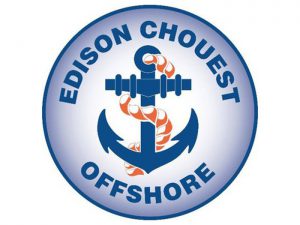
JULY 15, 2016 — The Alaska Journal reports that Edison Chouest Offshore (ECO) will be adding new vessels to its fleet when it takes over the oil tanker escort and spill response
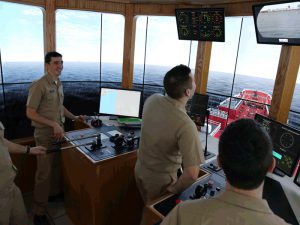
An increasingly technical world – on board and ashore – and a growing mariner shortage have conspired to make maritime education and training more important than ever. The maritime world plays a significant role in moving the global economy and its goods, people and power. Educational institutions ensure those responsible for moving the world’s assets across the seven seas are well-qualified and prepared for their roles.
According to the latest BIMCO and ICS manpower report, the industry is facing a need for nearly 150,000 officers in the next decade and is already short 16,000 officers. The need to keep men and women sailing on their licenses for longer, and to recruit and train new officers, is growing steadily. In times of high demand, it is not unknown for the quality of a product to decrease. Yet that is an unconscionable risk for the maritime industry and its regulatory agencies. In fact, requirements to earn and upgrade a license are becoming more stringent, meaning that maritime educators must take additional steps to ensure the necessary requirements are met for all entering the fleet.
Additionally, vessels and operating procedures are becoming increasingly complicated; it is imperative that the men and women in charge of them and their cargo know what they are doing.
At SUNY Maritime College in New York City, the professional education and training department is responsible for giving professional mariners the continuing education they need to stay current and qualified under changing regulations. The program also trains students for limited tonnage licenses, playing an important role in the nation’s brownwater fleet.
For more than 100 years, SUNY Maritime has educated and trained merchant mariners, changing its curriculum, facilities and program offerings to align with the needs of the industry and U.S. Coast Guard requirements. Once again, the college is working to meet the growing mariner demand and to ensure that they succeed in their pursuit of Coast Guard mariner credentials.
The changes – among others – include offering additional courses to help licensed mariners maintain and update their skills as well as building facilities to train new mariners. The Manila amendments to the International Convention on Training, Certification and Watchkeeping standards, approved in 2010, go into effect at the end of the year. Safety is, and always will be, paramount to the maritime landscape, and the Manila amendments are designed to enhance crew safety at sea.
The amendments require, among other things, that all mariners take regular courses in basic training, renew their endorsements, and pass leadership courses to upgrade and maintain their credential.
No longer is experience at sea enough.
Basic training, which covers all the subjects most important to a vessel’s safety, still teaches basic firefighting, personal survival techniques, personal safety and social responsibility, and basic first aid. But now mariners will need to take the course, or a version of it, every five years in their professional careers.
After the end of the year, mariners entering the profession will take the original 40-hour course that has been taught for years and which introduces them to onboard safety operations. A 16-hour refresher course will be required for all who have not accrued 360 days of sea time in the past five years. An 8-hour course has been designed for mariners who have accrued the 360 days in a five-year period.
Nor is it enough anymore to earn lifeboatman, fast rescue boat or tankerman-PIC endorsements once and carry them for life. Once the Manila amendments go into effect, mariners must renew these qualifications to keep them.
These courses are being developed by a variety of players, including state maritime academies like SUNY Maritime.
Industry professionals, executives and thought-leaders have always prized safety over all else—safety of their crews, their vessels and, lastly, of their cargo. But tragedies like the sinking of the El Faro serve as an unfortunate reminder to all of us of how dangerous our industry can be and how necessary these skills are for the well-being of all who sail.
Safety practices and awareness are, of course, the most important thing that maritime educators impart to their students. This is a dangerous field and there are too many things that can go wrong.
But the Manila amendments have also recognized the increasing importance of a second set of skills related to teamwork and leadership, not only for those in leadership positions but for all officers onboard a vessel.
The essence of Coast Guard licensure training, at SUNY Maritime and elsewhere, is focused on developing mates and engineers who can work together and make decisions. The Coast Guard requires a regimented lifestyle and, though interpretations of that lifestyle vary, the focus is in developing an individual’s character and leadership skills so that the safety of the crew and vessel are paramount, rather than individual wants and needs.
But the regimental program at SUNY Maritime, in keeping with STCW standards, now includes leadership and teamworking training, while professional mariners can come to the campus to take the individual course. The course will focus on case studies, workload management, maritime conventions and regulations, and situational awareness to enhance decision making skills.
STCW standards also include training for those looking to advance into personnel management positions on both the deck and engine sides of vessel operations. More training has been added to ensure that officers can work together to, once again, ensure the vessel’s operations go as smoothly and safely as possible. The 35-hour course is required for all chief mates, masters, second engineers and chief engineers. It focuses on managing and training shipboard personnel, building situational awareness, and optimizing the use of engineering and bridge resources, among other things.
These requirements are the latest expansion of the necessary training for licensed mariners.
As the scope of training expands, so too have the resources and facilities at the academies which have grown and become more sophisticated. Ships and other vessels are increasingly technical and, though training ships and cadet commercial shipping assignments offer real-world experience onboard, it is unwise to allow a future mariner to sail without previous knowledge and virtual experience.
Simulation technology has become so advanced that cadets and mariners can gain experience with nearly any situation before ever stepping onboard. In a simulator, future mariners can practice standing watch anywhere in the world on a vessel powered by any form of fuel. As the global fleet changes from steam to diesel to, increasingly, natural gas in an effort to reduce pollution, these opportunities help professional mariners gain the experience they need to sail for a variety of companies and on a variety of vessels.
All of the maritime academies have expanded their simulation centers and systems in recent years. At SUNY Maritime, in the past year programs have built or expanded a tug and barge simulator and a full mission engine room simulator, which is enhanced with a 20 desktop station classroom to allow as many students to gain experience as possible.
These technologies, as complex as they are, can only produce data from which a student can learn. The equipment allows for—indeed it requires—a large amount of human interaction.
After all, the human element is by far the most important element of any vessel at any time and in any place. Interpreting the data onboard a simulator allows a professional mariner to correctly interpret the data coming from a vessel’s systems and act based on that data to ensure the safety of the vessel, cargo and crew.
Simulators and simulation systems are imperative for cadets and mariners to become familiar with the equipment onboard a vessel and that they will someday use and be responsible for. Simulation allows them to learn, within a controlled environment, what a navigational bridge or engine room is capable of and how to harness it to move a vessel safely from one port to another. Such training exercises allow students to make mistakes and learn from them without risking millions of dollars, environmental damage and lives.
Simulators at SUNY Maritime, as at the other academies, are nothing new. SUNY Maritime has several Class A bridge simulators, radar/ARPA ECDIS labs and a liquid-cargo handling simulator. As onboard technology and simulation programs become increasingly sophisticated, maintenance and software upgrades ensure that future mariners are getting the best experience possible and that which most closely mimics the world they will be sailing in after earning their Coast Guard licenses.
Partnerships with maritime companies help to ensure not only that new mariners are getting the appropriate training, but that current mariners can also return to maintain and upgrade their credentials. The ATB simulator at Maritime College has been supported and expanded through the generosity of Bouchard Transportation Company, Inc. The latest expansion includes two Class B stations to allow coordination between up to three tugs and a barge.
Mariners and cadets working in SUNY Maritime’s engine room simulator have the additional benefit of being able to train remotely through cloud technology. The simulator is no longer bound to the room in which it is confined, and trainees are able to spend additional time with the equipment. This capability, combined with digital textbooks, means that the possibilities for training and continuing education are endless.
These simulators and additional STCW courses help our nation’s mariners adapt to and thrive in an ever-changing industry. The same way that any other professional must adapt to the changes brought on by the information revolution and a changing world, so too must the mariner. Indeed, since the mariner travels the world and plays such a large role in the functioning of the global economy, the needs for continuing education and training are perhaps even more important than most other professions.
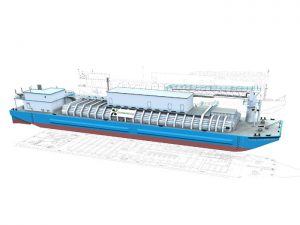
JUNE 24, 2016—Shipbuilder Conrad Shipyard, Morgan City, LA, has formed a new business unit focused on developing designs and building vessels for the Liquefied Natural Gas (LNG) market. As you might recall
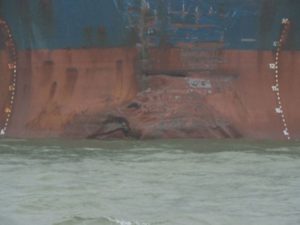
JUNE 9, 2016 — The National Transportation Safety Board said yesterday that the probable cause of the 2015 collision of the Conti Peridot and the Carla Maersk in the Houston Ship Channel
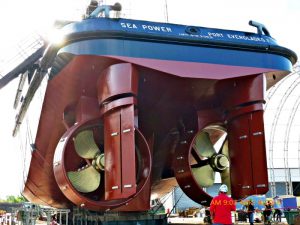
MAY 31, 2016—BAE Systems Southeast Shipyards, Mobile, AL, recently launched the first of two 12,000 hp ATB tugs for Sea-Vista ATB, LLC. One of the interesting features of the tug M/V Sea